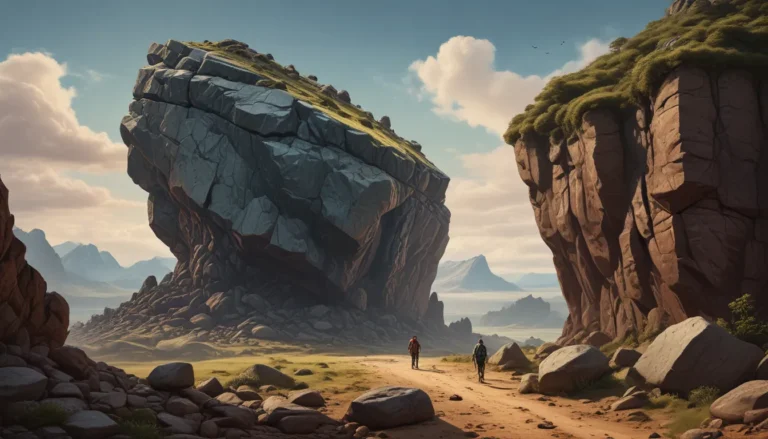A Note About Images: The images used in our articles are for illustration purposes only and may not exactly match the content. They are meant to engage readers, but the text should be relied upon for accurate information.
Have you ever marveled at the majestic sand dunes or witnessed the power of a dust storm in action? These awe-inspiring sights are all thanks to aeolian processes, the geological phenomena driven by the mighty force of wind. In this article, we will embark on an enlightening journey through 17 fascinating facts about aeolian processes. From the formation of sand dunes to the erosion of rocks, these processes have sculpted the Earth’s surface for millions of years, leaving an indelible mark on landscapes across the globe.
Unraveling the Mysteries of Aeolian Processes
Aeolian processes, named after Aeolus, the Greek god of the wind, refer to the intricate geological phenomenon where wind acts as a sculptor, transporting and depositing sediment to shape the landforms we see today. This natural force plays a crucial role in shaping various landscapes worldwide, from deserts to coastlines and beyond.
The Magnificence of Deserts Shaped by Wind
Deserts, such as the vast Sahara in Africa and the enchanting Mojave in the United States, serve as prime examples of the transformative power of aeolian processes. These arid regions showcase wind-blown sand dunes and erosional features that stand as testaments to the enduring impact of wind on the Earth’s surface.
The Wind: Nature’s Sculptor
As the primary driving force behind aeolian processes, wind breathes life into the geological formations we witness. From the gentle caress that creates delicate sand ripples to the fierce gusts that whip up powerful sandstorms, wind plays a pivotal role in shaping our planet’s landscapes.
The Dynamic Nature of Sand Dunes
One of the most visually captivating results of aeolian processes is the constant evolution of sand dunes. These majestic formations shift and morph in size and shape over time, showcasing the dynamic interplay between wind and sediment in reshaping the Earth’s surface.
Dust Storms: Nature’s Spectacular Display
Aeolian processes can give rise to breathtaking dust storms, where fine particles are lifted into the air and carried over vast distances. These awe-inspiring events not only showcase the power of wind but also have significant environmental and health implications.
Beyond Earth: Aeolian Processes in the Cosmos
While aeolian processes have left their mark on Earth, they also play a role in shaping the landscapes of other planets and moons in our solar system. Just like on Mars, where wind action has crafted vast fields of sand dunes, aeolian processes transcend planetary boundaries.
Loess Deposits: Nature’s Fertile Legacy
Loess deposits, fine-grained sediments carried and deposited by wind, are not only visually stunning but also fertile grounds that support agricultural activities. These deposits stand as a testament to the diverse impacts of aeolian processes on the Earth’s surface.
The Artistry of Rock Formations
Over time, aeolian processes can carve and sculpt rocks into unique formations, such as natural arches and pillars. These mesmerizing creations, like the iconic Delicate Arch in Utah’s Arches National Park, showcase the artistic prowess of wind in shaping the Earth’s landscapes.
Sandstone Cliffs: Testaments to Wind’s Power
Through relentless erosion, wind can sculpt sandstone cliffs into breathtaking formations with distinct shapes and contours. These impressive cliffs, like the Twelve Apostles in Australia, stand as majestic monuments to the enduring influence of aeolian processes.
Unveiling the Mystery of Sandstorms
During intense wind events, loose sand can be whipped into the air, creating powerful sandstorms that command attention with their sheer force. These natural phenomena not only impact visibility but also underscore the raw power of aeolian processes in action.
The Intricate Beauty of Sand Ripples
On sandy surfaces, wind action creates intricate sand ripples that stand as delicate patterns etched by nature’s hand. These small-scale formations, which form perpendicular to the wind direction, add a touch of elegance to desert and coastal landscapes.
Nutrient Transport Through Dust Deposition
Wind’s ability to transport dust particles over vast distances plays a vital role in nutrient cycling across ecosystems. This essential process contributes to soil fertility in certain regions, highlighting the interconnectedness of aeolian processes with environmental sustainability.
The Perils of Wind Erosion
In regions where wind erosion outpaces sediment deposition, land degradation can occur, posing threats to agricultural productivity and ecological balance. Understanding the mechanisms of wind erosion is crucial for safeguarding the Earth’s delicate ecosystems.
Shaping Coastlines with Sand Spits and Bars
Aeolian processes not only impact terrestrial landscapes but also contribute to the formation of sand spits and bars along coastlines. These elongated landforms, sculpted by wind-driven sediment transport, serve as dynamic features that shape our coastal environments.
Towering Heights of Sand Dunes
Under the influence of aeolian processes, sand dunes can reach impressive heights, with some towering over hundreds of meters. The colossal dunes of the Namib Desert stand as a testament to the relentless force of wind-driven deposition in shaping our planet’s landscapes.
Harnessing the Power of Aeolian Resources
Throughout history, humans have recognized and utilized the benefits of aeolian processes. Ancient civilizations, such as the Egyptians, leveraged wind-assisted ships and harnessed wind energy for various practical purposes, showcasing the enduring legacy of wind’s influence on human societies.
Embracing the Legacy of Aeolian Processes
From the enchanting beauty of sand dunes to the raw power of dust storms, aeolian processes continue to shape our world in profound ways. By studying and understanding these natural phenomena, we gain insight into the dynamic nature of our planet’s landscapes, paving the way for informed conservation and sustainability efforts.
In Conclusion
Aeolian processes stand as testament to the intricate interplay between wind and geology, shaping our environment in remarkable ways. From the intricate patterns of sand ripples to the towering heights of sand dunes, these processes leave an indelible mark on the Earth’s surface. By delving into the mysteries of aeolian processes, we unlock a deeper understanding of the dynamic forces at play in shaping our planet’s landscapes.
FAQs
Q: What are Aeolian processes?
A: Aeolian processes encompass the geological actions carried out by wind, including erosion, transportation, and deposition of materials like sand, silt, and dust.
Q: What causes Aeolian processes?
A: Aeolian processes are primarily driven by the movement of air and the presence of loose materials on the Earth’s surface. Wind speed, direction, and particle characteristics all influence the shaping of landscapes through these processes.
Q: What are some famous examples of Aeolian landscapes?
A: Famous Aeolian landscapes include the Sahara Desert, Namib Desert sand dunes, the Bisti/De-Na-Zin Wilderness, and the Badlands National Park.
Q: How do Aeolian processes affect the environment?
A: Aeolian processes play a vital role in sediment transportation, nutrient cycling, and landform creation. However, excessive wind erosion can lead to soil degradation, vegetation loss, and dust storm formation.
Q: How do scientists study Aeolian processes?
A: Scientists study Aeolian processes through field observations, laboratory experiments, and computer modeling. Techniques like wind tunnel tests, remote sensing, and sediment sampling aid in understanding the mechanisms behind these processes.
Exploring the Wonders of Aeolian Processes
As we unravel the mystique of aeolian processes, we gain a deeper appreciation for the profound influence of wind on our planet’s landscapes. From the delicate dance of sand ripples to the majestic heights of sand dunes, these natural phenomena encapsulate the captivating beauty and power of nature’s craftsmanship. So, the next time you find yourself in the presence of a wind-sculpted landscape, take a moment to marvel at the intricate workings of aeolian processes that have shaped our world for millennia.






